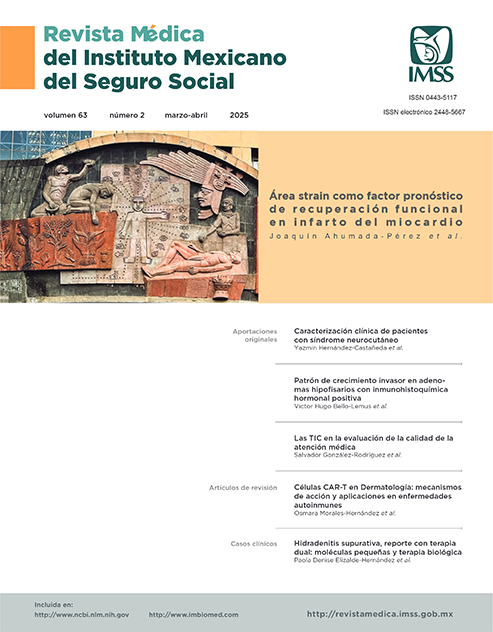Child development in children with exclusive breastfeeding
Main Article Content
Keywords
Breast Feeding, Growth and Development, Psychomotor Performance
Abstract
Abstract
Background: Exclusive breastfeeding (EBF) is essential for child development, offering cognitive, motor and emotional benefits.
Objective: To determine child development in children with exclusive breastfeeding.
Material and methods: A longitudinal and retrospective study was conducted on children aged 1 to 24 months, with and without exclusive breastfeeding (EBF). Development was assessed at three time points (baseline, three months, and six months) using the Infant Development Assessment Test, which measures gross motor skills, fine motor skills, language, and social aspects. Child-related variables (age, sex, and gestational age) and maternal variables (age, socioeconomic status, and education level) were analyzed using descriptive and inferential statistics with SPSS v24.
Results: In a sample of 359 children, with a median age of 9 months (1-24), 52.4% were girls, with a median gestational age of 39 weeks (37-42). The median maternal age was 24 years (16-38), with a predominance of middle-high socioeconomic status (70.8) and secondary or higher education (55.4%). 52.9% of children received EBF. Initially, 83.1% of children with EBF obtained a green score in development, increasing to 97.8% at three months and 99.4% at six months. In contrast, in children without EBF, only 28.9% obtained a green score initially, increasing to 34.9% at three months and 48.5% at six months (p < 0.001).
Conclusion: Children with EBF showed superior development compared to those without EBF, underlining the importance of breastfeeding in psychomotor, cognitive and social development.
References
Organización Mundial de la Salud & Fondo de las Naciones Unidas para la Infancia. Global Strategy for Infant and Young Child Feeding. OMS; 2023. Disponible en: https://www.who.int/es/ news-room/fact-sheets/detail/infant-and-young-child-feeding
Diaz-Aranda DL, Leyva-Yataco L, Ordoñez-Ccora G, et al. Evaluación de la Efectividad de la Lactancia Materna Exclusiva en la Prevención de Enfermedades Crónicas en la Madre y el Bebé. PolodelConocimiento. 2023;2538-51. Disponible en: https://dialnet.unirioja.es/descarga/articulo/9152390.pdf
Victora CG, Bahl R, Barros AJD, et al. Breastfeeding in the 21st century: epidemiology, mechanisms, and lifelong effect. The Lancet. 2016;387(10017):475-90. doi: 10.1016/ S0140-6736(15)01024-7
González-Castell LD, Unar-Munguía M, Bonvecchio-Arenas A, et al. Lactancia materna. Salud Publica Mex. 2024;66 (4) 498-508. Disponible en: https://saludpublica.mx/index.php/ spm/article/view/15898
Calero-Garcia SK, Salinas-Umaña RN, Espinoza-Mesa AI. Nivel de crecimiento-desarrollo y el antecedente de uso de lactancia materna exclusiva en niños en edad preescolar. LATAM Revista Latinoamericana de Ciencias Sociales y Humanidades. 2024;5(5). doi: https://doi.org/10.56712/latam.v5i5.2592
ENSANUT. Encuesta Nacional de Salud y Nutrición Continua 2021. México; 2021. Disponible en: https://ensanut.insp.mx/encuestas/ensanutcontinua2021/index.php#:~:text=La%20ENSANUT%20Continua%202021%20aporta,que%20ha%20 estado%20expuesta%20al
Salinas M, Schonhaut L, Muñoz S, et al. Trayectoria del desarrollo psicomotor según estado nutricional en niños alimentados con lactancia materna. Andes Pediatrica. 2022;93(4):535. Disponible en: http://dx.doi.org/10.32641/andespediatr.v93i4.4107
Barrera-Rojas MA. Redes de Apoyo a la Lactancia Materna Exclusiva (RALME). Una aproximación conceptual y caracterización en México. Bol Med Hosp Infant Mex. 2024;81(2). Disponible en: https://doi.org/10.24875/bmhim.23000108
Kronborg H, Foverskov E. Multifactorial influence on duration of exclusive breastfeeding; a Danish cohort study. PLoS One. 2020;15(9):e0238363. Disponible en: https://doi.org/10.1371/journal.pone.0238363
Morales-López S, Colmenares-Castaño M, Cruz-Licea V, et al. Recordemos lo importante que es la lactancia materna. Revista de la Facultad de Medicina. 2022;65(2):9-25. Disponible en: http://doi.org/10.22201/fm.24484865e.2022.65.2.02
Gobierno de Salud de México. Vigilancia del desarrollo en la primera infancia. 2019 [cited 2024 Nov 4]. Disponible en: https://www.gob.mx/salud/censia/articulos/desarrollo-infantil-vitales-los-primeros-anos-de-vida-131171?state=published
Santos-Álvarez N, Barajas-González P, Gómez-Alonso C. Evaluación del desarrollo infantil en niños de 2 a 4 años en el primer nivel de atención. Rev Enferm Inst Mex Seguro Soc. 2021;29(2):57-64.
Secretaria de salud. Lineamiento de Operación 2020 del Componente Desarrollo en la Infancia. Mexico; 2020. Disponible en: https://www.gob.mx/cms/uploads/attachment/file/563149/ Desarrollo_en_la_Infancia.pdf
Romero-Daza AI, Danies-Valverde J, Ortiz-Jiménez M. Lactancia materna y deserción escolar en estudiantes madres de una facultad de salud. Revista Repertorio de Medicina y Cirugía. 2020;29(1). Disponible en: https://revistas.fucsalud.edu.co/index.php/repertorio/article/view/945
Orcajo-Castelan R, Sidonio-Aguayo B, Alcacio-Mendoza JA, et al. Análisis comparativo de pruebas de tamiz para la detección de problemas en el desarrollo diseñadas y validadas en México. Boletín Médico del Hospital Infantil de México. 2015;72(6):364-375. Disponible en: https://doi.org/10.1016/j. bmhimx.2015.11.004
Alonso-López N, Hernández-Valle V, Pedroza-Vargas ME, et al. Prevalencia de alteraciones en el neurodesarrollo en niños de población rural de Oaxaca evaluados mediante la prueba Evaluación de Desarrollo Infantil. Rev Neurol. 2023;76(02):41. doi: 10.33588/rn.7612.2023134
Tovar-Moreno C, Karlis-Rangel MA, Villarreal-Guerra SA, et al. Comparison between the KARVI scale and the Child Development Evaluation test (EDI) as a screening tool for suspected neurodevelopmental delay. Bol Med Hosp Infant Mex. 2024;81(1). Disponible en: https://doi.org/10.24875/bmhim.23000062
De Castro F, Vázquez-Salas RA, Villalobos A, et al. Contexto y resultados del desarrollo infantil temprano en niños y niñas de 12 a 59 meses en México. Salud Publica Mex. 2019;61(6): 775. Disponible en: https://doi.org/10.21149/10560
Kramer MS, Kakuma R. Optimal duration of exclusive breast-feeding. Cochrane Database of Systematic Reviews. 2012; 2012(8). Disponible en: 10.1002/14651858.CD003517.pub2
Ballard O, Morrow AL. Human Milk Composition. Pediatr Clin North Am. 2013;60(1):49-74. doi: 10.1016/j.pcl.2012.10.002
Itagi SK. Effect of Breastfeeding Practices on Psychomotor Development of Infants. Biomed J Sci Tech Res. 2023;49(5). doi: 10.26717/BJSTR.2023.49.007856
Lovcevic I. Associations of breastfeeding duration and cognitive development from childhood to middle adolescence. Acta Paediatr. 2023;112(8):1696-705. doi: 10.1111/apa.16837
Labatjo R, Saleh I, Blongkod FR. EXCLUSIVE BREAST-FEEDING AND INFANT PSYCHOMOTOR DEVELOPMENT. National Nutrition Journal. 2023;1-7. Disponible en: https://www.researchgate.net/publication/374930958_Exclusive_Breastfeeding_and_Infant_Psychomotor_Development
Oddy WH, Kendall GE, Li J, Jacoby P, et al. The Long-Term Effects of Breastfeeding on Child and Adolescent Mental Health: A Pregnancy Cohort Study Followed for 14 Years. J Pediatr. 2010;156(4):568-74. doi: 10.1016/j.jpeds.2009.10.020
Sacker A, Quigley MA, Kelly YJ. Breastfeeding and Developmental Delay: Findings From the Millennium Cohort Study. Pediatrics. 2006;118(3):e682-9. doi: 10.1542/peds.2005-3141
Martínez-Vicuña EÁ, Pogyo-Morocho MV, Encalada-Zumba JP, et al. Beneficios de la lactancia materna en el recién nacido. ConcienciaDigital. 2024;7(3):26-45 doi: https://doi.org/ 10.33262/concienciadigital.v7i3.3076


